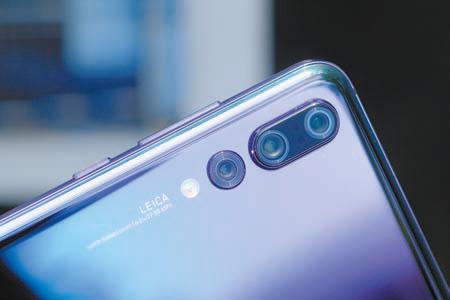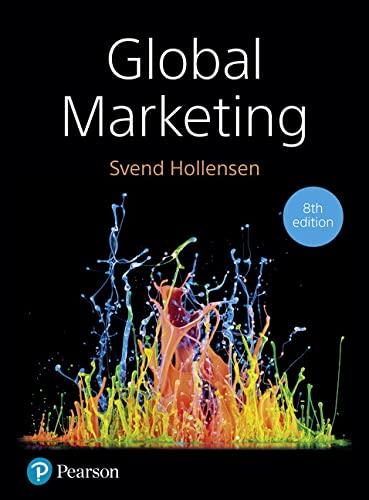Huawei Technologies Co Ltd (in the following called Huawei) is the worlds largest telecom equipment maker (in
Question:
Huawei Technologies Co Ltd (in the following called ‘Huawei’) is the world’s largest telecom equipment maker (in the B2B market) and China’s largest telephone-
network equipment maker.
Huawei was founded in 1987 by Ren Zhengfei. The company started out as a reseller of phone switches and worked its way up by manufacturing its own products.
It is today known as a global information and communications technology (ICT) solution provider.
The company was initially focused on its domestic market of China, but has since expanded into over 170 countries, and claims to serve more than one-third of the world’s population.
In 2017 Huawei generated a revenue of US$92,549 billion, with US$7,276 billion as net profit. By the end of 2017 Huawei had 180,000 employees.
As of 2008, Huawei ranked first in terms of global market share in the B2B mobile softswitches market, tied with Sony Ericsson for lead market share in mobile broadband cards by revenue, ranked second in the optical hardware market, and ranked third in mobile network equipment. In 2009, Huawei was ranked no.
2 in global market share for radio access equipment.
Analysis in this case will focus on Huawei’s consumer business. This segment contributes to more than a third of its revenue, of which smartphones is the main product. Huawei has gained significant momentum in the smartphone market in recent years, which propelled it to the top three position in the market, after Samsung and Apple.
Security concerns in the West In the US, officials and politicians within the federal government have raised concerns that Huawei-made telecommunications equipment may be designed to allow unauthorized access by the Chinese government and the Chinese People’s Liberation Army, given that Ren Zhengfei, the founder of the company, served as an engineer in the army in the early 1980s.
On 17 April 2018, the Federal Communications Commission (FCC) held a preliminary, 5–0 vote on rules forbidding the use of government subsidies to purchase telecom equipment from companies deemed to be a risk to national security. A draft of the policy specifically named Chinese Huawei and ZTE as examples.
The same day, the company revealed plans to downplay the U.S. market as part of its future business plans, citing the government scrutiny as having impeded its business there.
The US government’s ongoing security concerns over Huawei’s products and services has kept the company largely away from the second-largest smartphone market.
In late 2018 and beginning of 2019 the problems for Huawei became worse. Some key countries, among others the USA, Australia and the UK banned Huawei from development of their 5G networks over fears it could make national infrastructure accessible to Chinese government. Huawei continuously states that the Chinese government cannot legally compel telecoms firms to install backdoors or listening devices in other nations, and that blocking Huawei from the 5G market could result in higher costs for both consumers and telecom companies.
With its long struggles in penetrating the US market, Huawei will be diverting most of its marketing budget previously set aside for the US into Europe where consumers and the local government have been more receptive towards the brand. In Europe, Huawei’s brand profile has increased considerably as a result of its aggressive marketing campaigns and numerous high profile football sponsorships with Atlético Madrid, AC Milan and FC Barcelona.
This has helped it to see major share gains in markets like Spain, Italy and France over the last two years.
Huawei in the smartphone market In July 2003, Huawei established their smartphone department and by 2004, Huawei shipped their first phone, the C300. The U626 was Huawei’s first 3G phone in June 2005 and in 2006, Huawei launched the first Vodafone branded 3G handset, the V710.
Huawei also partnered with Google to build the Nexus 6P in 2015. In March 2018, Huawei announced its new flagship smartphone, the P20 Pro, which will be the world’s first smartphone with three rear cameras.
In the Chinese home market the company quickly gained momentum along with its Chinese counterparts, such as Xiaomi, Oppo and Vivo, by capitalizing on the smartphone boom in China. Its existing relationships with telecommunication (telco) operators via its carrier business have also allowed the company to build scale more quickly than its smaller but equally aggressive companies such as Oppo and Vivo. In China, owning a Huawei phone is no longer seen as inferior to global brands such as Apple or Samsung. In fact, according to a survey by Huawei, 55 per cent of high-end Mate 9 users come from tier-1 and -2 cities in China, and postgraduates and above consumers account for over 50 per cent, indicating its growing brand prestige.
Huawei’s early gains in the smartphone market were primarily the result of its aggressive pricing strategy with its low to mid-range smartphones. This allowed it to gain significant share in emerging markets, such as the Middle East and Africa and China, and this has proven successful in driving volume growth.
Developed markets has been one of the key volume drivers for Huawei due to its broad smartphone portfolio across different price points. The availability of its phones through major carriers and growing brand recognition have helped to expand its reach, particularly in Middle East and Africa.
However, Asia Pacific excluding China remains a challenging market for Huawei. With over 80 per cent of mobile phones sold without a contract in South-
#ast Asia in 2017, Huawei faces greater challenges in expanding in the region. Huawei’s competitor Oppo, was able to establish an early lead in South-east Asia as it identified early the need to focus on setting up many offline retail stores across cities. Oppo was also able to significantly increase its brand visibility in South-east Asia with an aggressive marketing strategy such as celebrities and local sports sponsorships, and incentivising retailers and sales reps to sell its phones by offering higher commissions. Huawei will need to play catch up and get its brand out there with consumers.
In a bid to reinvent itself as a premium brand and increase its brand awareness beyond China, Huawei has secured partnerships with respected brands in their own fields such as Leica Camera AG, GoPro and Porsche Design, which allows it to better position itself as a global brand with quality products. These partnerships help it to increase its brand equity and expand its footprint in developed markets such as Western Europe.
The tri-lens camera of the Huawei P20 Pro was easily the phone’s biggest talking point; it’s a world first

for Huawei and serves as a unique feature for its latest flagship.
However, what was interesting to see with the 2017 P20 series was that Huawei is no longer just banking on the Leica brand name to sell its flagship phones. It is slowly carving out its own brand name by leveraging on its own research in artificial intelligence (AI) and the AI-powered Kirin 970 chip in its phones to make it easier for novice photographers to take good photos.
Using AI, the camera on the P20 phones are able to automatically identify more than 500 scenarios in 19 categories such as food, text, fireworks and flowers.
The camera will select the correct photography modes and adjust the settings automatically.
The AI-driven photography will help it to appeal to the wider mass of consumers, in particular the millennials and Generation Z who are active on social media platforms yet may not possess the technical knowledge to be professional photographers. While AI-driven photography is still in its nascent stage, the use cases are clear. It is also easy for Huawei to drive home the message to consumers that AI will be able to help novice photographers take professional looking photos. As Huawei continues to invest in its own R&D, it may eventually no longer need to rely heavily on the Leica brand to sell its phones. This is similar to how Lenovo bought IBM’s PC business and brand in 2005 only to phase out the use of the IBM logo three years later as it reached a stage where it no longer needed the IBM brand to establish credibility and consumers could resonate with the Lenovo brand.
AI will also be a key differentiating factor for manufacturers like Huawei to leverage on consumer data to create a personalized customer experience that will increase brand loyalty.
In the following you will find the most important data about the world market for smartphones.....
Questions
You are hired by the Huawei top management group in China as a specialist in international marketing. You have been asked to perform the following tasks:
1. Discuss and evaluate Huawei’s key competitive advantages in the global smartphone market
2. Which type of organization structure should Huawei use for the global sales of its smartphones?
3. How could Huawei make use of the GAM (Global Account Management) principle?
4. Which ‘metrics’ would you recommend to use, when measuring the communication and financial effects of using ‘Helene Christensen’ as a celebrity endorser for Huawei P20 Pro?
Step by Step Answer:






